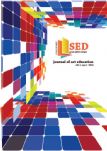YÜKSELİŞİ VE ÖNCÜ SANATÇILARIYLA SOYUT DIŞAVURUMCULUK
THE RISE AND THE LEADING ARTISTS OF ABSTRACT EXPRESSIONISM
Author(s): Pelin Avşar Karabaş, Ahmet PolatSubject(s): Cultural history, Visual Arts, Sociology of Art
Published by: Sanat ve Dil Araştırmaları Enstitüsü
Keywords: Abstract Expressionsm; Action Painting; Post-Painterly Abstraction; Color Field Painting; New York School;
Summary/Abstract: In the last quarter of 19. century, the Industrial Era has led to major changes in the social life. These changes cause introverted effects that occur in individuals inner world as a result of mental activities, and the reflection of these effects on art caused new art trends and insights to be revealed in 20. century. The social, economic, environmental elements that constitute “Abstract Expressionism”, the movement’s emergence, development, reflect on art and the artists are examined within this screening model research. Abstract Expressionism is consist of “Action Painting”, “Post-Painterly Abstraction” and “Color Field Painting”. This movement is all about rejection of objects or objective forms. Especially expression of introverted emotions are considered important and a pure concept illustration is taken as a basis. The movement, formed in New York between years 1940-1950, has been the subject of many discussions with the new impressive and striking explanation it brought to the international art environment. Jackson Pollock, Willem de Kooning, Franz Kline, Robert of Dundee, Mark Rothko, Clyfford Still and Barnett Newman are the major artists of this movement which is also known as “New York School” in America nurtured by political and social change.
Journal: SED-Sanat Eğitimi Dergisi
- Issue Year: 4/2016
- Issue No: 1
- Page Range: 37-52
- Page Count: 16
- Language: Turkish

